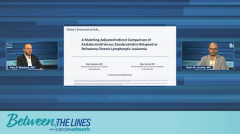
Clinical Trials With BTK Inhibitors in Relapsed/Refractory CLL
Focused discussion on key clinical trial data behind currently available BTK inhibitors for patients with relapsed/refractory chronic lymphocytic leukemia.
Episodes in this series

Transcript:
Alan P. Skarbnik, MD: Having that in mind, what you just said about the differences between BTK inhibitors and the studies that they were evaluated and taking into consideration that it's complicated to compare agents across different trials because there's a number of biases and caveats. But, in the absence of a head-to-head comparison trial, we need to make do with the data that we have and try to do it in a more organized fashion. With this paper, [we attempt] to do this matching-adjusted indirect comparison between acalabrutinib and zanubrutinib, which are the 2 second generation BTK inhibitors that are approved for CLL at this point. As we know, both agents have been compared against ibrutinib in 2 separate trials. The ALPINE study [NCT03734016] compares zanubrutinib versus ibrutinib in a relapsed/refractory CLL population, however, unrestricted by cytogenetic abnormalities. So, all-comers with all risks of disease, whether having high-risk disease with a deletion [of chromosome] 17p or TP53 mutation or lower-risk disease.
They're all enrolled in the study, which is more of the general population than we see in our clinic, anyways. The median prior lines of therapy in the study was 1. However, the study that compared acalabrutinib against ibrutinib, ELEVATE-RR [NCT02477696] focused on the higher-risk patients, so patients had to have deletion 17p or deletion 11q, or both. At that time, we considered deletion 11q as a higher-risk feature, particularly in patients who would receive chemotherapy. Now, we know that for patients who received BTK inhibitor, it doesn't really pose a higher risk. Nevertheless, it was a population significantly more enriched for patients with deletion 17p, therefore, changing the evaluation here, the ability to compare those two populations becomes more restricted and the median prior lines of therapy in the population was 2. This is the study that was done earlier, when people didn't have many options.
They were exposed to more chemotherapy in general, before. Trying to match those populations becomes challenging because the number of patients in the higher risk trial becomes very small. So, instead of using ELEVATE-RR, we used the study ASCEND [NCT00135226], which compared acalabrutinib versus chemo or bendamustine and rituximab or idelalisib plus rituximab but is a very similar population as ALPINE [NCT02970318]. It was not restricted by cytogenetic abnormalities, so all-comers and median [number of] prior lines of therapy in that patient group was 1. The populations are a little more equitable against each other and allow for, potentially, a better comparison. We still need to match. It is a non-anchored match because the comparator was different, but, nevertheless, we used a validated method to do that.
Ryan W. Jacobs, MD: In short, when you want to compare two trials, it makes sense to choose the two with the most similar patient populations?
Alan P. Skarbnik, MD: Correct, yes.
Transcript edited for clarity.
Newsletter
Stay up to date on recent advances in the multidisciplinary approach to cancer.




















































































